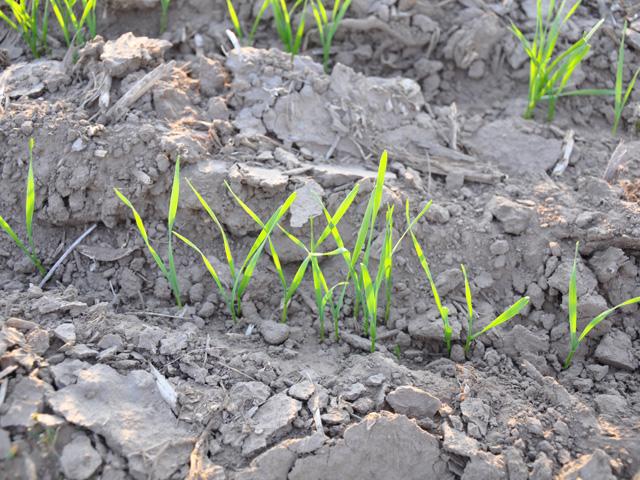Droughty Wheat Dilemma
Wheat Farmers Face Widespread Drought Amid Market Volatility
NEW ORLEANS (DTN) -- At a time of soaring prices and newfound attention on wheat production, this should be a heady spring for U.S. wheat farmers.
But where Shawn Kimbrell farms in the High Plains of Texas, the outlook is dusty and discouraging. His winter wheat fields got just enough moisture to germinate and emerge in the fall, but since then, his fields have suffered through a long, dry winter. "We got just enough rain to get the wheat out of the ground, so it could sit there and die," the Sunray, Texas, farmer noted wryly.
Likewise, in Moses Lake, Washington, Phillip Gross' winter wheat fields got a welcome 2 inches of rain in the fall. But after a summer of dryness and record heat, the moisture has been nowhere near enough to refill the region's drained soil moisture profiles, he said.
Both Kimbrell and Gross are in New Orleans attending Commodity Classic this week to celebrate their award-winning wheat from last year -- Gross had a field of irrigated spring wheat that hit 184.36 bushels per acre, and Kimbrell's dryland winter wheat field yielded 211% above his county average, earning them spots among the 2021 National Wheat Yield Contest's national winners.
But as both growers look toward the 2022 growing season, they have little expectation of contest-level production years. Mostly, they are hoping their wheat acres eke out enough grain to fill their new-crop contracts and cover their input costs.
The situation is, unfortunately, a common one for wheat growers this year, noted DTN Ag Meteorologist John Baranick. Soft red wheat-growing regions are in better shape, but "all of the primary hard red winter wheat areas are currently in drought, as well as all white wheat in the Pacific Northwest," he said. "For spring and durum wheat, drought remains in all areas except for the eastern Dakotas into Minnesota; they are currently drought-free with the demarcation right around the Missouri River."
P[L1] D[0x0] M[300x250] OOP[F] ADUNIT[] T[]
Looking ahead, Baranick sees little room for optimism for many of these wheat-growing regions.
"Precipitation is forecast to be below normal for hard red winter wheat throughout this summer," he added. "Outside of a couple of chances for some moderate precipitation here in March, the outlook is not favorable. That coincides with above-normal temperatures and will have impacts for corn and soybean production as well." (See more on DTN's spring forecast here: https://www.dtnpf.com/….)
The droughty forecast for wheat production comes at a bad time, noted DTN Lead Analyst Todd Hultman.
"The threat of drought, sooner for hard red winter wheat and later for hard red spring wheat, is just another bullish layer of concern that could add to upward price pressures in 2022," he noted.
With the world focused on an ongoing conflict between two major wheat producers, Russia and Ukraine, wheat prices in the U.S. have reacted dramatically, he noted.
"Wheat prices have a large fear premium in the market, as no one knows how this will turn out or if Ukraine will have much or any crop production in 2022," Hultman noted. "On top of that, we've had specs holding a large number of short positions, especially in Chicago wheat that were trapped until Tuesday, March 8, largely unable to get out as prices went limit up five consecutive sessions. Wheat prices are seeing two-sided trading Wednesday, March 9, but this remains a dangerous, unstable market with lots of uncertainty ahead."
Amid this volatility, the widespread drought conditions have left wheat farmers frustrated -- watching as some cash bids soar beyond $11 to $12 per bushel but unable to risk contracting too much new-crop grain.
"Wheat, of course, 'dies 11 times' before you harvest it, but we had a good-looking crop last fall, and then it had nothing -- I mean nothing -- all winter," said Josh Svaty, who farms near Ellis, Kansas. "So how does a producer contract in that environment?"
There are multiple layers of difficulty facing wheat farmers this spring, agreed Hultman.
"Even in normal times, making forward sales is difficult in wheat because many have experienced a time when they had a good-looking crop that got ruined shortly before harvest," he noted. "This year, you either have to have a banker behind you for margin calls or you will likely take a discount trying to sell a new-crop price at your local elevator."
The situation brings into the spotlight a warning from DTN contributor Tregg Cronin at DTN's Ag Summit in December, urging growers to spread their business around to different elevators as a way of spreading risk, Hultman noted. "That may be especially good advice this year as financial problems tend to surface when markets make big, unexpected moves," Hultman explained.
See more from DTN on the wheat markets here: https://www.dtnpf.com/… and here: https://www.dtnpf.com/….
Emily Unglesbee can be reached at Emily.unglesbee@dtn.com
Follow her on Twitter @Emily_Unglesbee
(c) Copyright 2022 DTN, LLC. All rights reserved.






